Nesting Elterman Model and Spatiotemporal Linear Mixed-Effects Model to Predict the Daily Aerosol Optical Depth over the Southern Central Hebei Plain, China
Abstract
:1. Introduction
2. Dataset and Methodologies
2.1. Study Area
2.2. Dataset
2.2.1. Meteorological Variables and Elevation Data
2.2.2. Multi-Angle Implementation of Atmospheric Correction (MAIAC) AOD
2.2.3. Data Integration
2.3. Methodologies
2.3.1. Retrieval Method
2.3.2. Model Validation
3. Results
3.1. Descriptive Statistics of ST-LME
3.2. ST-LME Model Fitting and Validation
3.3. Comparisons of AOD Prediction by ST-ERM with the R-ERM
3.4. Universality Validation of ST-ERM
3.5. AOD Spatial Variation Characteristics
4. Discussion
4.1. Comparison with Other Studies with Similar Methods
4.2. Strengths and Weaknesses of the ST-ERM
4.3. Uncertainties of ST-ERM
5. Conclusions
Author Contributions
Funding
Institutional Review Board Statement
Informed Consent Statement
Data Availability Statement
Conflicts of Interest
References
- Chen, B.; Ye, Y.; Tong, C.; Deng, J.; Wang, K.; Hong, Y. A novel big data mining framework for reconstructing large-scale daily MAIAC AOD data across China from 2000 to 2020. GISci Remote Sens. 2022, 59, 670–685. [Google Scholar] [CrossRef]
- Chen, L.X.; Zhang, B.; Zhu, W.Q.; Zhou, X.J.; Luo, Y.F.; Zhou, Z.J.; He, J.H. Variation of atmospheric aerosol optical depth and its relationship with climate change in China east of 100° E over the last 50 years. Theor. Appl. Climatol. 2008, 96, 191–199. [Google Scholar] [CrossRef]
- Chen, Y.; Shi, R.; Chao, W.; Chen, Y.; Wei, G. Estimating aerosol optical depth based on regional optimized Peterson model. J. Geogr. Inf. Sci. 2013, 15, 241. (In Chinese) [Google Scholar] [CrossRef]
- Chen, Z.Y.; Jin, J.Q.; Zhang, R.; Zhang, T.H.; Chen, J.J.; Yang, J.; Ou, C.Q.; Guo, Y. Comparison of different missing-imputation methods for MAIAC (multiangle implementation of atmospheric correction) AOD in estimating daily PM2.5 levels. Remote Sens. 2020, 12, 3008. [Google Scholar] [CrossRef]
- Elterman, L. Relationships between vertical attenuation and surface meteorological range. Appl. Opt. 1970, 9, 1804–1810. [Google Scholar] [CrossRef]
- Guo, Y.; Tang, Q.; Gong, D.Y.; Zhang, Z. Estimating ground-level PM2.5 concentrations in Beijing using a satellite-based geographically and temporally weighted regression model. Remote Sens. Environ. 2017, 198, 140–149. [Google Scholar] [CrossRef]
- Holben, B.N.; Eck, T.F.; Slutsker, I.; Tanré, D.; Buis, J.P.; Setzer, A.; Vermote, E.; Reagan, J.A.; Kaufman, Y.J.; Nakajima, T. AERONET-A federated instrument network and data archive for aerosol characterization. Remote Sens. Environ. 1998, 66, 1–16. [Google Scholar] [CrossRef]
- Jiang, T.; Chen, B.; Nie, Z.; Ren, Z.; Xu, B.; Tang, S. Estimation of hourly full-coverage PM2.5 concentrations at 1-km resolution in China using a two-stage random forest model. Atmos. Res. 2021, 248, 105146. [Google Scholar] [CrossRef]
- Kloog, I.; Sorek-Hamer, M.; Lyapustin, A.; Coull, B.; Wang, Y.; Just, A.C.; Schwartz, J.; Broday, D.M. Estimating daily PM2.5 and PM10 across the complex geo-climate region of Israel using MAIAC satellite-based AOD data. Atmos. Environ. 2015, 122, 409–416. [Google Scholar] [CrossRef]
- Hoff, R.M.; Christopher, S.A. Remote sensing of particulate pollution from space: Have we reached the promised land? J. Air Waste Manag. Assoc. 2009, 59, 645–675. [Google Scholar] [CrossRef]
- Song, Z.; Fu, D.; Zhang, X.; Han, X.; Song, J.; Zhang, J.; Wang, J.; Xia, X. MODIS AOD sampling rate and its effect on PM2.5 estimation in North China. Atmos. Environ. 2019, 209, 14–22. [Google Scholar] [CrossRef]
- Koschmieder, H. Theorie der horizontalen Sichtweite. Beitr. Phys. Freien Atmos. 1924, 12, 171–181. [Google Scholar]
- Levy, R.C.; Remer, L.A.; Kleidman, R.G.; Mattoo, S.; Ichoku, C.; Kahn, R.; Eck, T.F. Global evaluation of the Collection 5 MODIS dark-target aerosol products over land. Atmos. Chem. Phys. 2010, 10, 10399–10420. [Google Scholar] [CrossRef]
- Li, F.; Zhang, L.; Wei, Q.; Yang, Y.; Han, F.; Li, W.; Zhao, C.; Wang, W. An improved method for retrieving aerosol optical depth using the ground-level meteorological data over the South-central Plain of Hebei Province, China. Atmos. Pollut. Res. 2022, 13, 101334. [Google Scholar] [CrossRef]
- Li, L.; Franklin, M.; Girguis, M.; Lurmann, F.; Wu, J.; Pavlovic, N.; Breton, C.; Gilliland, F.; Habre, R. Spatiotemporal imputation of MAIAC AOD using deep learning with downscaling. Remote Sens. Environ. 2020, 237, 111584. [Google Scholar] [CrossRef]
- Li, L.; Girguis, M.; Lurmann, F.; Pavlovic, N.; McClure, C.; Franklin, M.; Wu, J.; Oman, L.; Breton, C.; Gilliland, F.; et al. Ensemble-based deep Learning for estimating PM2.5 over California with multisource big data including wildfire smoke. Environ. Int. 2020, 145, 106143. [Google Scholar] [CrossRef]
- Lin, J.; Donkelaar, A.V.; Xin, J.; Che, H.; Wang, Y. Clear-sky aerosol optical depth over East China estimated from visibility measurements and chemical transport modeling. Atmos. Environ. 2014, 95, 258–267. [Google Scholar] [CrossRef]
- Lv, B.; Hu, Y.; Chang, H.H.; Russell, A.G.; Cai, J.; Xu, B.; Bai, Y. Daily estimation of ground-level PM2.5 concentrations at 4 km resolution over Beijing-Tianjin-Hebei by fusing MODIS AOD and ground observations. Sci. Total Environ. 2017, 580, 235–244. [Google Scholar] [CrossRef]
- Lyapustin, A.; Martonchik, J.; Wang, Y.; Laszlo, I.; Korkin, S. Multiangle Implementation of Atmospheric Correction (MAIAC): 1. radiative transfer basis and look-up tables. J. Geophys. Res. 2011, 116, D03210. [Google Scholar] [CrossRef]
- Lyapustin, A.; Wang, Y.; Laszlo, I.; Kahn, R.; Korkin, S.; Remer, L.; Levy, R.; Reid, J.S. Multiangle Implementation of Atmospheric Correction (MAIAC): 2. aerosol algorithm. J. Geophys. Res. 2011, 116, D03211. [Google Scholar] [CrossRef]
- Ma, Z.; Liu, Y.; Zhao, Q.; Liu, M.; Zhou, Y.; Bi, J. Satellite-derived high resolution PM2.5 concentrations in Yangtze River Delta Region of China using improved linear mixed effects model. Atmos. Environ. 2016, 133, 156–164. [Google Scholar] [CrossRef]
- McClatchey, R.A.; Fenn, R.W.; Selby, J.E.A. Optical Properties of the Atmosphere; Air Force Cambridge Research Lab: Bedford, UK, 1972. [Google Scholar]
- Meng, X.; Liu, C.; Zhang, L.; Wang, W.; Liu, Y. Estimating PM2.5 concentrations in Northeastern China with full spatiotemporal coverage, 2005–2016. Remote Sens. Environ. 2021, 253, 112203. [Google Scholar] [CrossRef] [PubMed]
- Peterson, J.T.; Fee, C.J. Visibility-atmospheric turbidity dependence at Raleigh, North Carolina. Atmos. Environ. 1981, 15, 2561–2563. [Google Scholar] [CrossRef]
- Qin, W.; Wang, L.; Lin, A.; Zhang, Z.; Bilal, M. Improving the estimation of daily aerosol optical depth and aerosol radiative effect using an optimized artificial neural network. Remote Sens. 2018, 10, 1022. [Google Scholar] [CrossRef]
- Qiu, J.H.; Lin, Y. A parametric model for the optical depth of atmospheric aerosols in China. Acta Meteorol. Sin. 2001, 59, 368–372. (In Chinese) [Google Scholar]
- Retalis, A.; Hadjimitsis, D.G.; Michaelides, S.; Tymvios, F.; Chrysoulakis, N.; Clayton, C.; Themistocleous, K. Comparison of aerosol optical thickness with in situ visibility data over Cyprus. Nat. Hazard. Earth Sys. 2010, 10, 421–428. [Google Scholar] [CrossRef]
- She, L.; Zhang, H.K.; Li, Z.; de Leeuw, G.; Huang, B. Himawari-8 Aerosol Optical Depth (AOD) retrieval using a deep neural network trained using AERONET observations. Remote Sens. 2020, 12, 4125. [Google Scholar] [CrossRef]
- Sun, X.; Yin, Y.; Sun, Y.; Sun, Y.; Liu, W.; Han, Y. Seasonal and vertical variations in aerosol distribution over Shijiazhuang, China. Atmos. Environ. 2013, 81, 245–252. [Google Scholar] [CrossRef]
- Tang, W.; Yang, K.; Qin, J.; Niu, X.; Lin, C.; Jing, X. A revisit to decadal change of aerosol optical depth and its impact on global radiation over China. Atmos. Environ. 2017, 150, 106–115. [Google Scholar] [CrossRef]
- Wang, K.; Dickinson, R.E.; Liang, S. Clear sky visibility has decreased over land globally from 1973 to 2007. Science 2009, 323, 1468–1470. [Google Scholar] [CrossRef]
- Wang, W.; He, J.; Miao, Z.; Du, L. Space–time linear mixed-effects (STLME) model for mapping hourly fine particulate loadings in the Beijing–Tianjin–Hebei region, China. J. Clean. Prod. 2021, 292, 125993. [Google Scholar] [CrossRef]
- Wu, J.; Luo, J.; Zhang, L.; Xia, L.; Zhao, D.; Tang, J. Improvement of aerosol optical depth retrieval using visibility data in China during the past 50 years. J. Geophys. Res. Atmos. 2014, 119, 13370–13387. [Google Scholar] [CrossRef]
- Wu, J.; Zhang, S.; Yang, Q.; Zhao, D.; Fan, W.; Zhao, J.; Shen, C. Using particle swarm optimization to improve visibility-aerosol optical depth retrieval method. npj Clim. Atmos. Sci. 2021, 4, 49. [Google Scholar]
- Xiao, Q.; Geng, G.; Cheng, J.; Liang, F.; Li, R.; Meng, X.; Xue, T.; Huang, X.; Kan, H.; Zhang, Q. Evaluation of gap-filling approaches in satellite-based daily PM2.5 prediction models. Atmos. Environ. 2021, 244, 117921. [Google Scholar] [CrossRef]
- Zhang, R.; Di, B.; Luo, Y.; Deng, X.; Grieneisen, M.L.; Wang, Z.; Yao, G.; Zhan, Y. A nonparametric approach to filling gaps in satellite-retrieved aerosol optical depth for estimating ambient PM2.5 levels. Environ. Pollut. 2018, 243, 998–1007. [Google Scholar] [CrossRef]
- Zhang, S.; Wu, J.; Fan, W.; Yang, Q.; Zhao, D. Review of aerosol optical depth retrieval using visibility data. Earth Sci. Rev. 2020, 200, 102986. [Google Scholar] [CrossRef]
- Zhang, Z.; Wu, W.; Wei, J.; Song, Y.; Yan, X.; Zhu, L.; Wang, Q. Aerosol optical depth retrieval from visibility in China during 1973–2014. Atmos. Environ. 2017, 171, 38–48. [Google Scholar] [CrossRef]
- Zhang, Z.Y.; Wu, W.L.; Fan, M.; Wei, J.; Tan, Y.; Wang, Q. Evaluation of MAIAC aerosol retrievals over China. Atmos. Environ. 2019, 202, 8–16. [Google Scholar] [CrossRef]
- Zhao, B.; Wang, S.; Ding, D.; Wu, W.; Chang, X.; Wang, J.; Xing, J.; Jang, C.; Fu, J.S.; Zhu, Y.; et al. Nonlinear relationships between air pollutant emissions and PM2.5-related health impacts in the Beijing-Tianjin-Hebei region. Sci. Total Environ. 2019, 661, 375–385. [Google Scholar] [CrossRef]
- Zhao, C.; Liu, Z.; Wang, Q.; Ban, J.; Chen, N.X.; Li, T. High-resolution daily AOD estimated to full coverage using the random forest model approach in the Beijing-Tianjin-Hebei region. Atmos. Environ. 2019, 203, 70–78. [Google Scholar] [CrossRef]
- Zhong, J.; Zhang, X.; Gui, K.; Wang, Y.; Che, H.; Shen, X.; Zhang, L.; Zhang, Y.; Sun, J.; Zhang, W. Robust prediction of hourly PM2.5 from meteorological data using LightGBM. Natl. Sci. Rev. 2021, 8, 115–126. [Google Scholar] [CrossRef] [PubMed]
- Zhou, M.; Wang, J.; Chen, X.; Xu, X.; Colarco, P.R.; Miller, S.D.; Reid, J.S.; Kondragunta, S.; Giles, D.M.; Holben, B. Nighttime smoke aerosol optical depth over U.S. rural areas: First retrieval from VIIRS moonlight observations. Remote Sens. Environ. 2021, 267, 112717. [Google Scholar] [CrossRef]
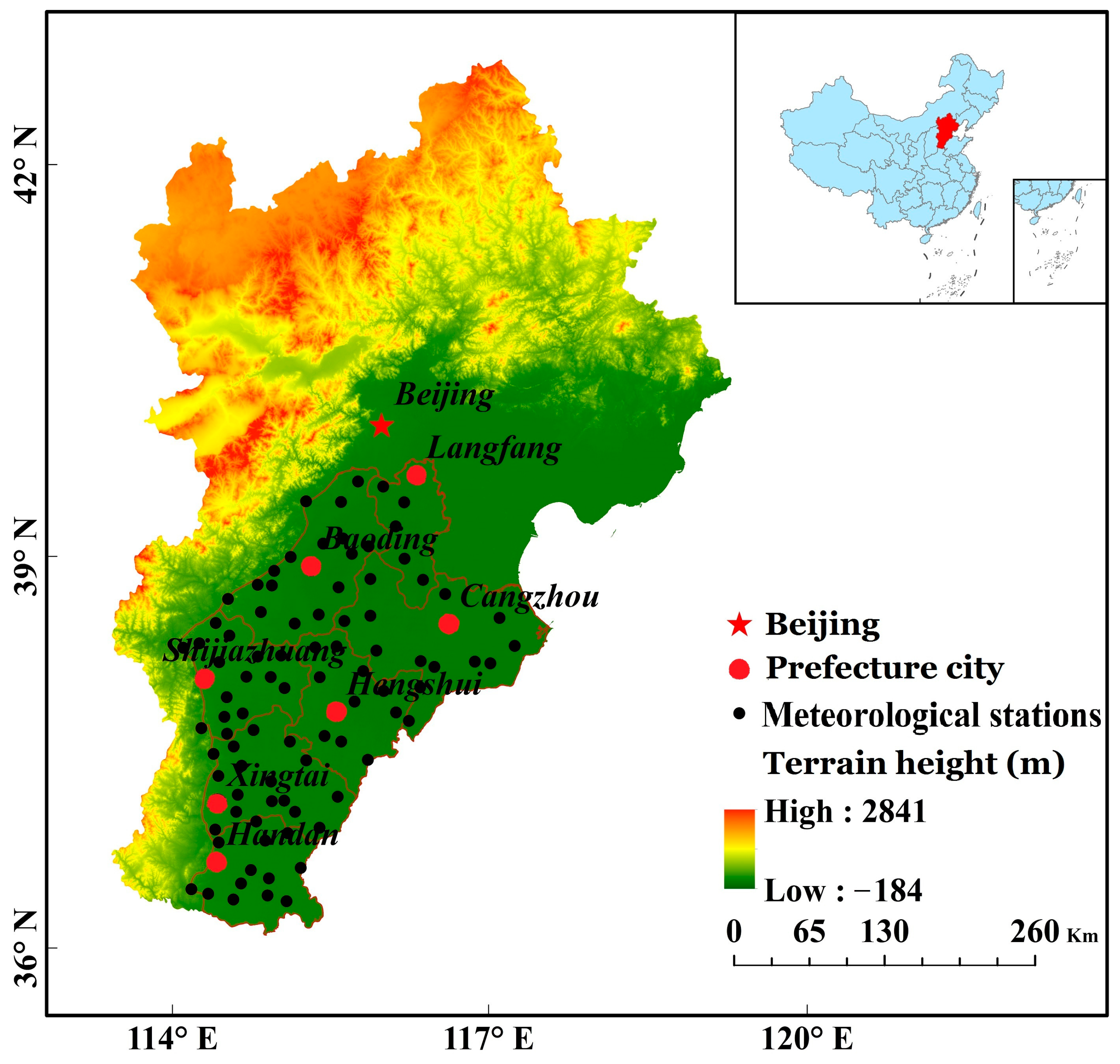
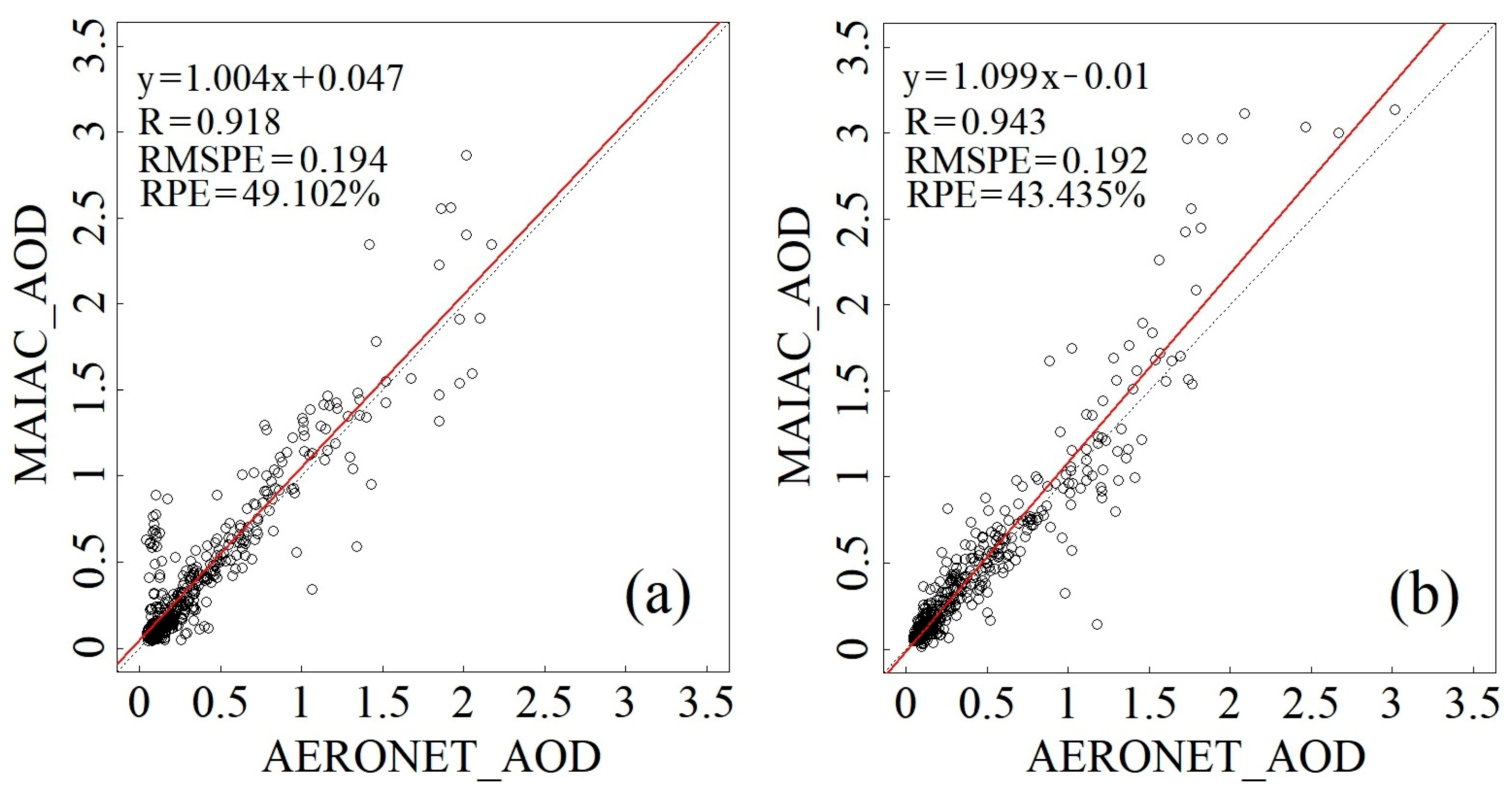
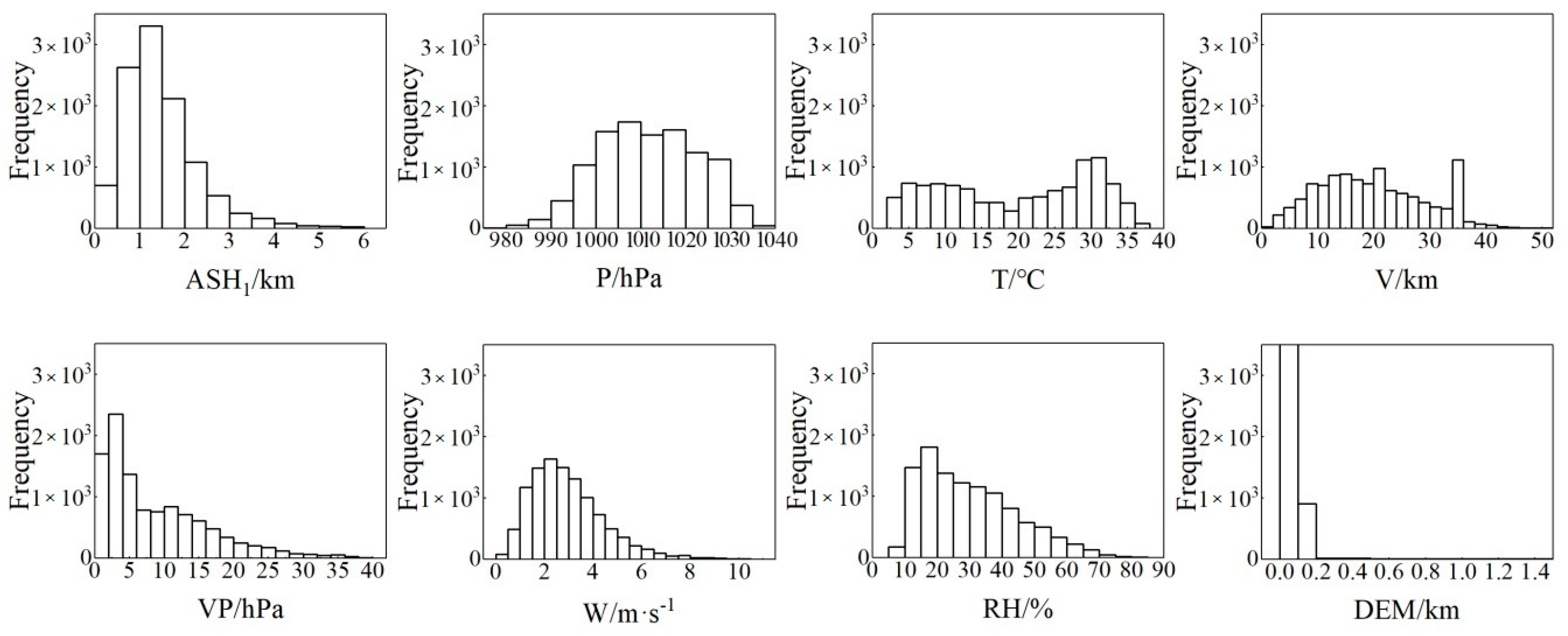
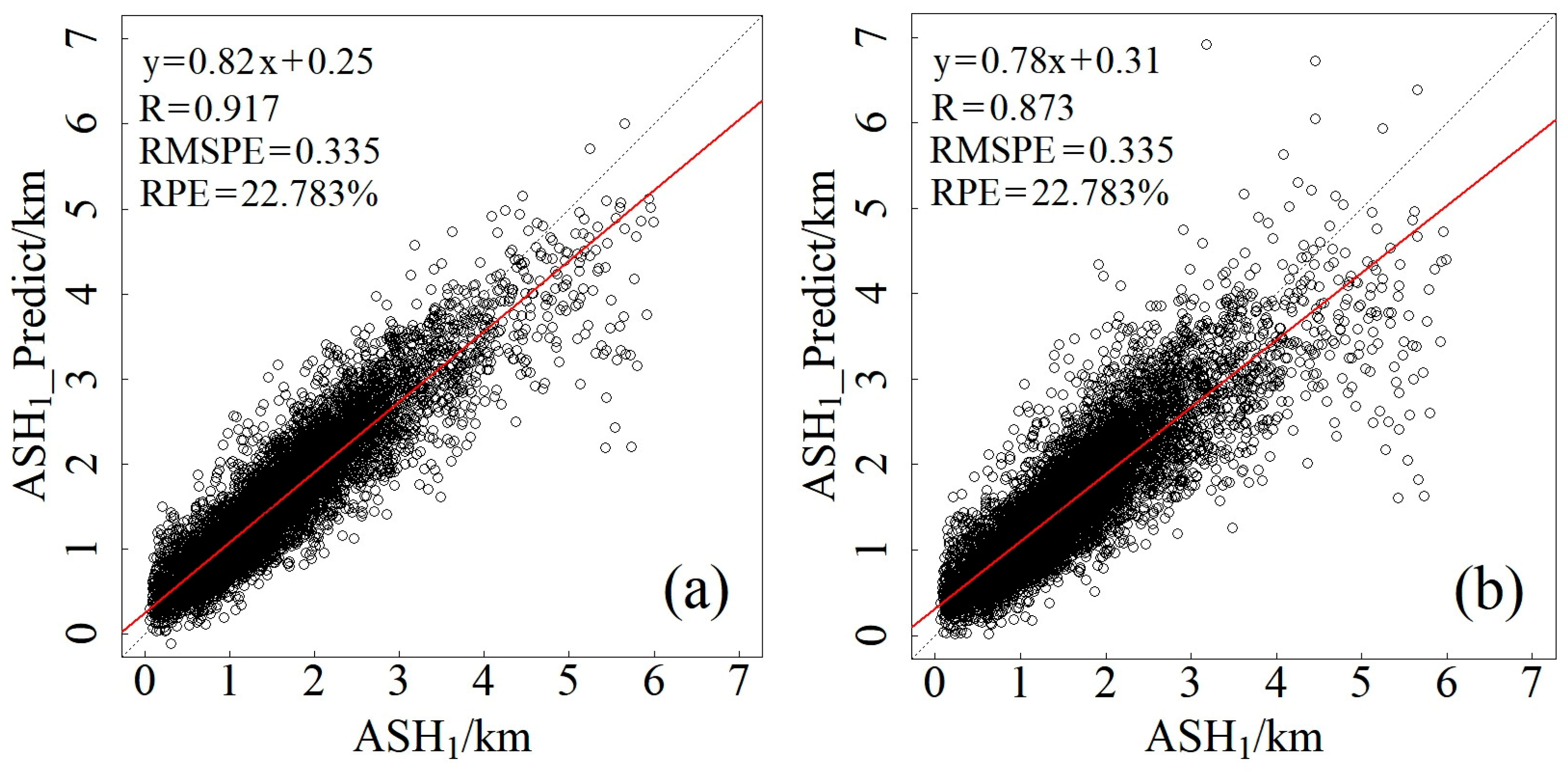
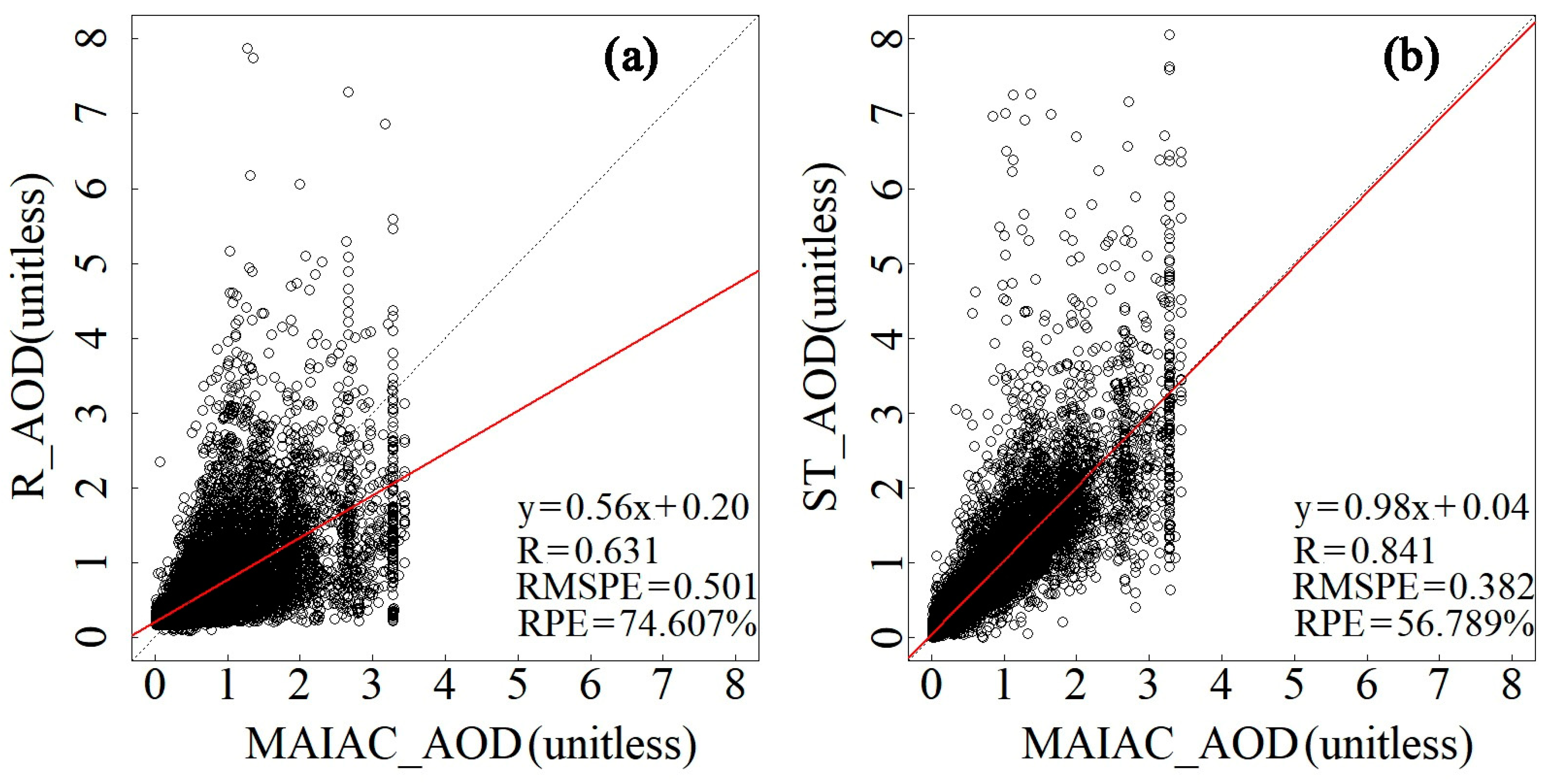
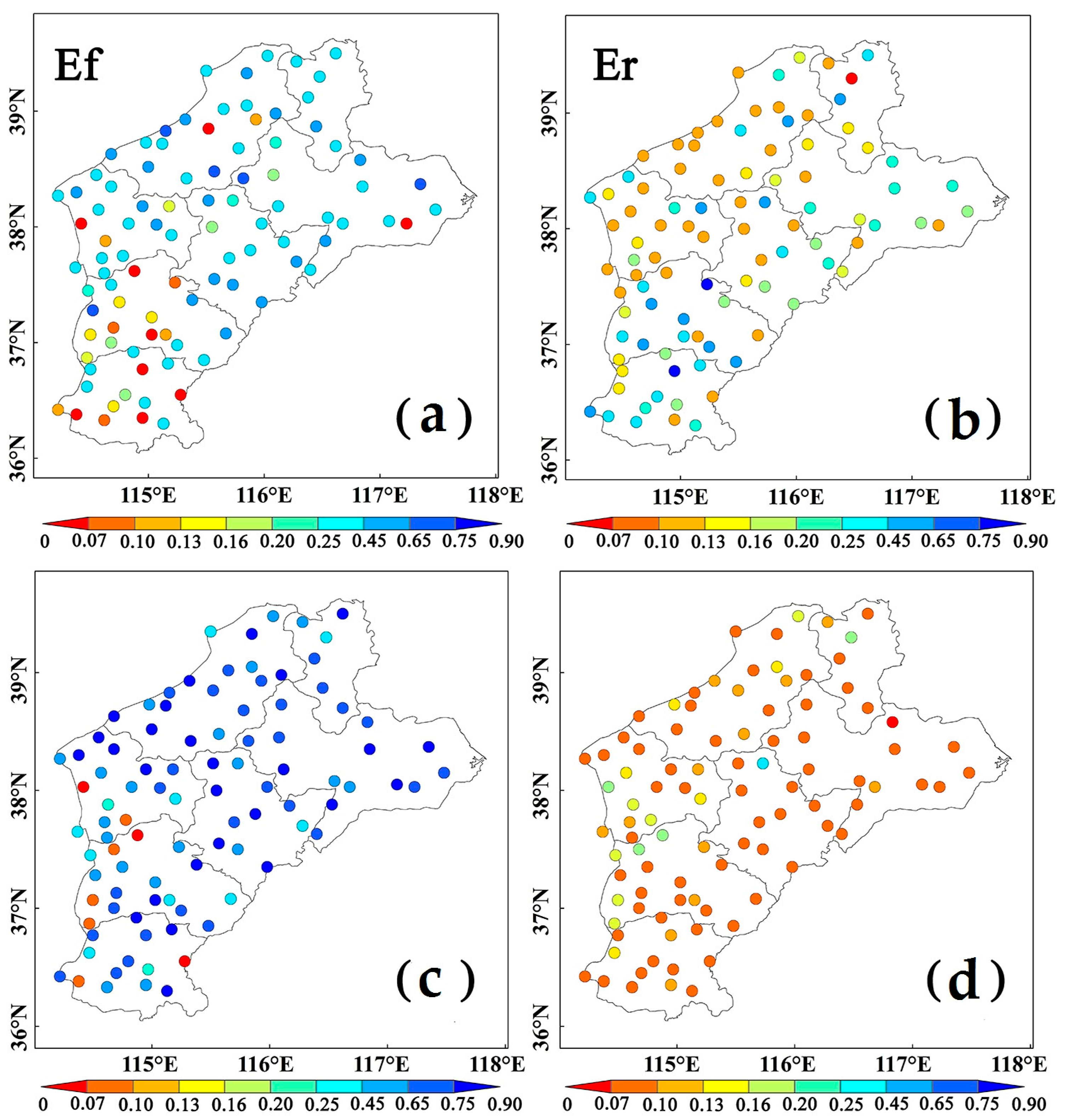


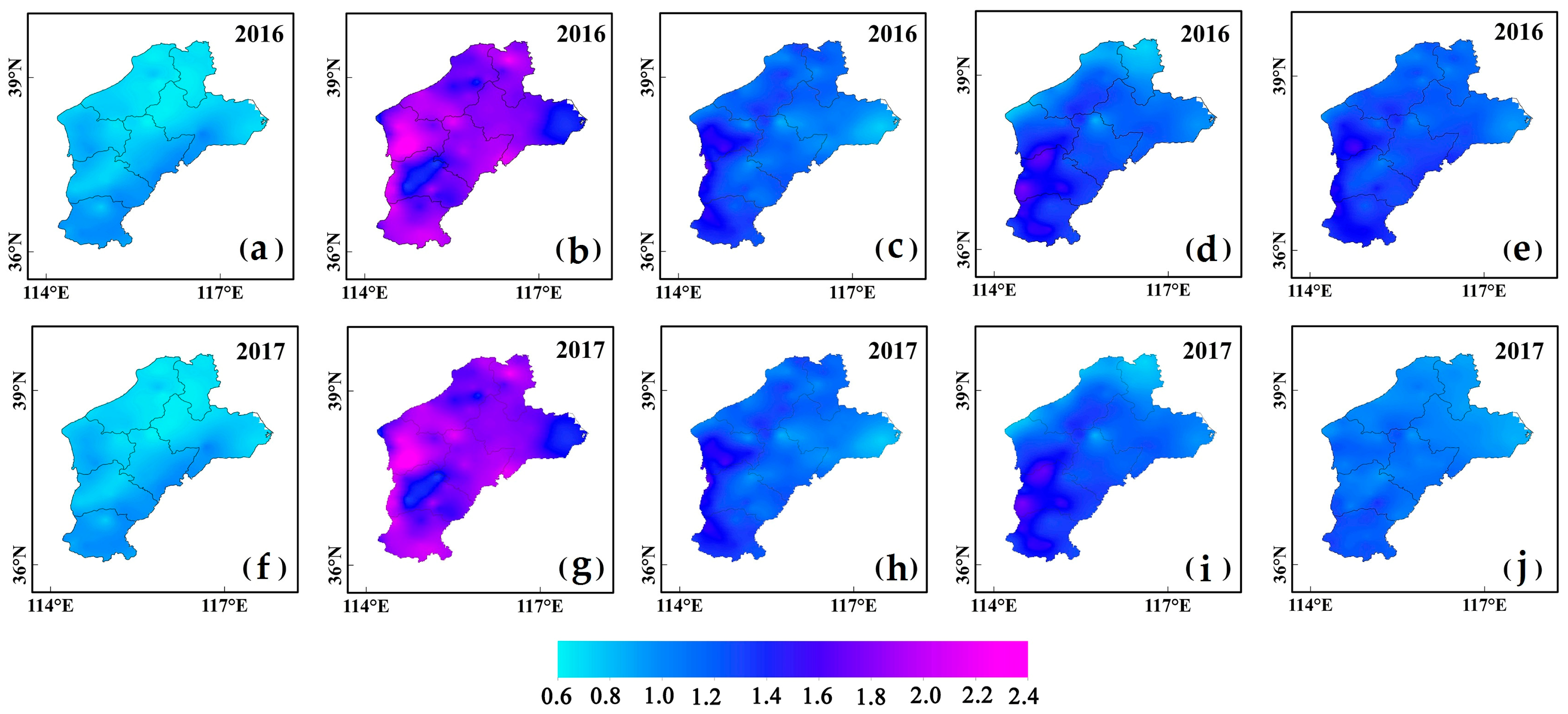
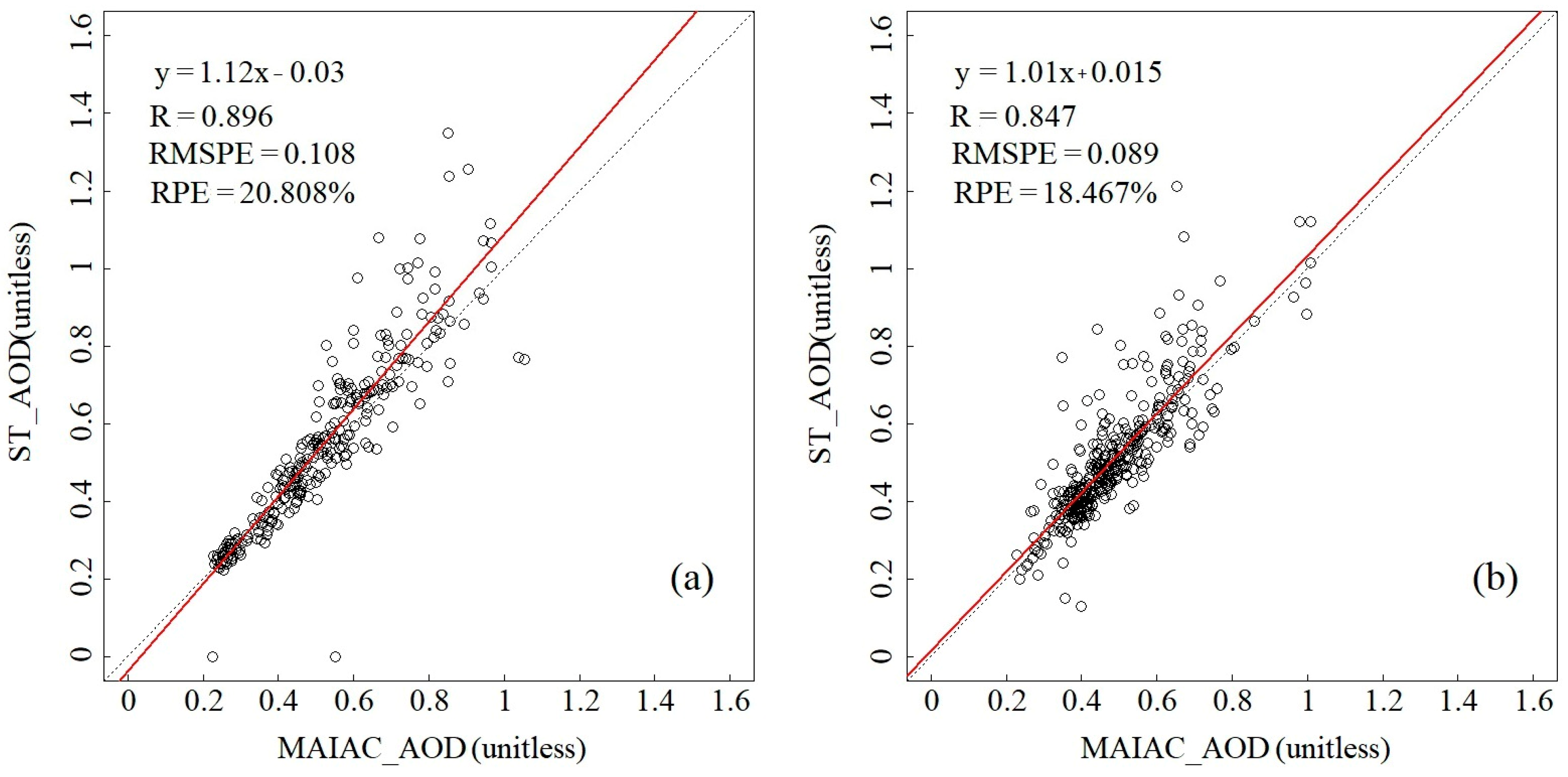
| Months | Correlations-R | |
|---|---|---|
| 2016 | 2017 | |
| 1 | 0.90 | 0.93 |
| 2 | 0.84 | 0.93 |
| 3 | 0.94 | 0.91 |
| 4 | 0.91 | 0.92 |
| 5 | 0.92 | 0.96 |
| 6 | 0.92 | 0.84 |
| 7 | 0.83 | 0.90 |
| 8 | 0.88 | 0.85 |
| 9 | 0.93 | 0.89 |
| 10 | 0.92 | 0.84 |
| 11 | 0.87 | 0.87 |
| 12 | 0.90 | 0.91 |
| Annual average | 0.90 | 0.90 |
| Variables | Mean | Minimum | Maximum | Std. Deviation |
|---|---|---|---|---|
| ASH1/km | 1.475 | 0.058 | 5.995 | 0.842 |
| P/hPa | 1011.690 | 976.500 | 1037.300 | 11.030 |
| T/°C | 19.822 | 2.200 | 38 | 10.217 |
| V/km | 19.944 | 0.600 | 50 | 9.539 |
| VP/hPa | 8.755 | 0.600 | 40.700 | 7.513 |
| W/m·s−¹ | 2.898 | 0 | 11.200 | 1.517 |
| RH | 0.297 | 0.050 | 0.890 | 0.147 |
| DEM/km | 0.046 | 0.004 | 1.454 | 0.085 |
| Model | Time Resolution | Study Area | Year | Model Validation | Reference | |||
|---|---|---|---|---|---|---|---|---|
| R | RMSPE | RPE | Slope | |||||
| M-Elterman | Monthly | China | 2006–2009 | 0.42–0.83 | 0.047–0.102 | 24–54% | - | [14] |
| KM-Elterman | Monthly | China | 2002–2010 | 0.71 | 0.208 | - | 0.529 | [24] |
| R-ERM | Monthly | SCHP | 2016–2017 | 0.69 | 0.20 | 23% | 1.063–0.945 | [2] |
| PSO-M-Elterman | Monthly | China | 2007–2014 | 0.69–0.75 | 0.051–0.071 | - | - | [1] |
| ST-ERM | Daily | SCHP | 2017 | 0.82 | 0.377 | 63.31% | 0.98 | This study |
| ST-ERM | Monthly | SCHP | 2017 | 0.85 | 0.089 | 18.467% | 0.98 | This study |
Disclaimer/Publisher’s Note: The statements, opinions and data contained in all publications are solely those of the individual author(s) and contributor(s) and not of MDPI and/or the editor(s). MDPI and/or the editor(s) disclaim responsibility for any injury to people or property resulting from any ideas, methods, instructions or products referred to in the content. |
© 2023 by the authors. Licensee MDPI, Basel, Switzerland. This article is an open access article distributed under the terms and conditions of the Creative Commons Attribution (CC BY) license (https://creativecommons.org/licenses/by/4.0/).
Share and Cite
Li, F.; Li, M.; Zheng, Y.; Yang, Y.; Duan, J.; Wang, Y.; Fan, L.; Wang, Z.; Wang, W. Nesting Elterman Model and Spatiotemporal Linear Mixed-Effects Model to Predict the Daily Aerosol Optical Depth over the Southern Central Hebei Plain, China. Sustainability 2023, 15, 2609. https://doi.org/10.3390/su15032609
Li F, Li M, Zheng Y, Yang Y, Duan J, Wang Y, Fan L, Wang Z, Wang W. Nesting Elterman Model and Spatiotemporal Linear Mixed-Effects Model to Predict the Daily Aerosol Optical Depth over the Southern Central Hebei Plain, China. Sustainability. 2023; 15(3):2609. https://doi.org/10.3390/su15032609
Chicago/Turabian StyleLi, Fuxing, Mengshi Li, Yingjuan Zheng, Yi Yang, Jifu Duan, Yang Wang, Lihang Fan, Zhen Wang, and Wei Wang. 2023. "Nesting Elterman Model and Spatiotemporal Linear Mixed-Effects Model to Predict the Daily Aerosol Optical Depth over the Southern Central Hebei Plain, China" Sustainability 15, no. 3: 2609. https://doi.org/10.3390/su15032609
APA StyleLi, F., Li, M., Zheng, Y., Yang, Y., Duan, J., Wang, Y., Fan, L., Wang, Z., & Wang, W. (2023). Nesting Elterman Model and Spatiotemporal Linear Mixed-Effects Model to Predict the Daily Aerosol Optical Depth over the Southern Central Hebei Plain, China. Sustainability, 15(3), 2609. https://doi.org/10.3390/su15032609







